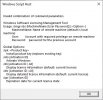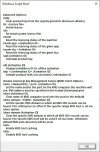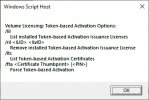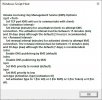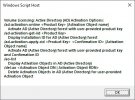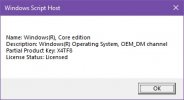I wanted to upgrade my daughter's machine from a old Dell Optiplex SFF running a 1st gen i5 and Win10 Pro to a HP Pavilion with 7th gen i5 that was running Win10 Home. I was also curious how well drive transplants work as I have never done one for a customer. I was mostly curious how MS or Windows handles the licensing issues. After imaging her old SSD (a full 2TB - pffft!) and setting the Pavilion to legacy boot, I dropped her old SSD in the new HP Pavilion and on first boot watched it go through the hardware updating or installing drivers and then into an automatic reboot. Tadaa! Up comes her desktop and all appears good. I check licensing and it's running Win10 Pro. I didn't really expect it to down-grade to Windows Home but I'm also surprised I'm not getting errors or licensing issues. The license for that machine is for Home yet it is running happily with Pro. Now what happens when I do a fresh install on her old machine? That Win10 Pro license can't be in use on two machines at once. Things that make you go hmmm........
You are using an out of date browser. It may not display this or other websites correctly.
You should upgrade or use an alternative browser.
You should upgrade or use an alternative browser.
Transplanting drive from one machine to another
- Thread starter Diggs
- Start date
Markverhyden
Well-Known Member
- Reaction score
- 11,100
- Location
- Raleigh, NC
Are you working with OEM versions of the OS on both machines?
Are you working with OEM versions of the OS on both machines?
Nope. Both had ISO installs.
alexsmith2709
Well-Known Member
- Reaction score
- 357
- Location
- UK
If its a retail copy, maybe thats why. I tried with an OEM install and it wouldnt activate (no surprise, but i did it without thinking about home/pro. It was a personal machine so it didnt matter anyway).
I guess because that key hasnt been used on thousands of machines Microsoft havent noticed so wont do anything about it
I guess because that key hasnt been used on thousands of machines Microsoft havent noticed so wont do anything about it
Markverhyden
Well-Known Member
- Reaction score
- 11,100
- Location
- Raleigh, NC
What does slmgr /dli produce on each machine. That'll give you the license type it's bound to.Nope. Both had ISO installs.
Last edited:
What does slmgr \dli produce on each machine. That'll give you the license type it's bound to.
Didn't know that command - Thanks @Markverhyden . On the newer Pavilion it says Pro and licensed. maybe that machine had Pro on it even though HP lists the specs as Home.
The one I'm worried about is the Pavilion. I actually do have the OEM SSD from it and I'm not sure where to find Home or Pro on the file system. Just that it is Win10. I suppose I can load the old registry hive and do some digging in there. I'm pretty rusty at remote registry manipulation but I can get there. Am I missing an easier way to query the old drive if it is Home or Pro?
alexsmith2709
Well-Known Member
- Reaction score
- 357
- Location
- UK
You should be able to find it in the registry if you go to HKEY_LOCAL_MACHINE\SOFTWARE\Microsoft\Windows NT\CurrentVersion and look at the EditionID key. I dont know if there is another wayDidn't know that command - Thanks @Markverhyden . On the newer Pavilion it says Pro and licensed. maybe that machine had Pro on it even though HP lists the specs as Home.
The one I'm worried about is the Pavilion. I actually do have the OEM SSD from it and I'm not sure where to find Home or Pro on the file system. Just that it is Win10. I suppose I can load the old registry hive and do some digging in there. I'm pretty rusty at remote registry manipulation but I can get there. Am I missing an easier way to query the old drive if it is Home or Pro?
britechguy
Well-Known Member
- Reaction score
- 4,852
- Location
- Staunton, VA
That Win10 Pro license can't be in use on two machines at once.
Wanna bet? And I'm not trying to imply that it's legal to do so, but given how lax MS has become in regard to licensing Windows 10 I would not be shocked if you could keep sticking cloned copies in multiple machines and have them all come up and work.
britechguy
Well-Known Member
- Reaction score
- 4,852
- Location
- Staunton, VA
I actually do have the OEM SSD from it and I'm not sure where to find Home or Pro on the file system. Just that it is Win10.
May I ask why it matters? That is presuming you're going to be doing a completely clean reinstall of Windows 10 on that machine. The installer itself has been pretty darned consistent, in my experience, in determining whether it's Home or Pro that should be activated based on what Microsoft already has logged on its servers for a given machine. That is if you're doing the install with internet connectivity.
Markverhyden
Well-Known Member
- Reaction score
- 11,100
- Location
- Raleigh, NC
I was looking for the distribution channel valueDidn't know that command - Thanks @Markverhyden . On the newer Pavilion it says Pro and licensed. maybe that machine had Pro on it even though HP lists the specs as Home.
The one I'm worried about is the Pavilion. I actually do have the OEM SSD from it and I'm not sure where to find Home or Pro on the file system. Just that it is Win10. I suppose I can load the old registry hive and do some digging in there. I'm pretty rusty at remote registry manipulation but I can get there. Am I missing an easier way to query the old drive if it is Home or Pro?
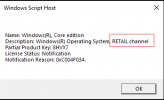
britechguy
Well-Known Member
- Reaction score
- 4,852
- Location
- Staunton, VA
I was looking for the distribution channel value
Yes, It says RETAIL. I'm not sure what that is telling me.
May I ask why it matters?
It doesn't really I guess. Just a learning experience. I'd not want to do this on a client's machine and get the licensing wrong or some other problem. Or as I said, it's just one of those things that make you go Hmmm......
the EditionID key
The EditionID key just reads "Core".
Down a few lines though "Product Name = Windows 10 Home" so that confirms the Pavilion had Home on it and is running currently running Pro (licensed) from a transplanted drive. Hmmm.....
britechguy
Well-Known Member
- Reaction score
- 4,852
- Location
- Staunton, VA
But what do you get on the Pavilion currently running Pro as output from SLMGR?
But what do you get on the Pavilion currently running Pro as output from SLMGR?
As I replied to Mark above it says "Pro" and "Licensed" as well as "RETAIL" but that as I now know is from the old Dell Optiplex. The Pavilion's original SSD's registry shows it was Home.
The Pavilion originally came with a 120 GB SSD and a 1TB HDD. I pulled both of those, changed to Legacy boot and dropped in the 2TB SSD from the old Optiplex and away it went. Weird thing is, every time the Pavilion looses power it reverts to Secure Boot. I'll have to see if the battery needs replacing on the MB.
britechguy
Well-Known Member
- Reaction score
- 4,852
- Location
- Staunton, VA
But, retail licenses can be moved from machine to machine legally. I presume this was a single machine license on the original machine and it's now a single machine license on the one it was transplanted in to.
I still have yet to understand how Microsoft is handling licensing these days, but you're far from the first person I've heard report that they did a "drive transplant," with everything including the OS on it, and it firing up as legally licensed on the machine into which it was transplanted.
This is precisely why I have said, and will continue saying, that beyond not doing what I know to be illegal, it's up to Microsoft whether something such as this is OK or not. When I have a circumstance such as yours, where I presume all of the original conditions for the retail license are still being met (meaning it's running on one, and only one machine, if it was a single machine license) and everything comes up A-OK by all official Microsoft checking mechanisms, my due diligence is done. It is not my job to decide whether or not a license is valid and legitimate beyond my doing my due diligence, and that's within reason, to ensure I'm not violating the original license agreement. Very often, and this is one of those times, full information is just not necessarily available about "the origin story" of a given Windows 10 instance/license. I have never felt obligated to "toss it away" if I do not know every scrap of information about it if MS seems to be perfectly happy to let it run.
It's interesting that the machine I'm typing from says it has a retail license, which I find very difficult to understand how that would have come about. This is a cast-off from one of my clients that had bad case damage (it's a laptop) that I decided to "revive from near death" just for amusement's sake. I maintained this machine for that client from the time it was new, and it came with Windows 8 Home, which I, once it was clear Windows 10 was stable, upgraded to Windows 10. It's still showing Home, but Retail channel. I've never had a pre-built machine (this is an HP Envy 15 series) show as having a Retail license "from the factory" other than this one.
I still have yet to understand how Microsoft is handling licensing these days, but you're far from the first person I've heard report that they did a "drive transplant," with everything including the OS on it, and it firing up as legally licensed on the machine into which it was transplanted.
This is precisely why I have said, and will continue saying, that beyond not doing what I know to be illegal, it's up to Microsoft whether something such as this is OK or not. When I have a circumstance such as yours, where I presume all of the original conditions for the retail license are still being met (meaning it's running on one, and only one machine, if it was a single machine license) and everything comes up A-OK by all official Microsoft checking mechanisms, my due diligence is done. It is not my job to decide whether or not a license is valid and legitimate beyond my doing my due diligence, and that's within reason, to ensure I'm not violating the original license agreement. Very often, and this is one of those times, full information is just not necessarily available about "the origin story" of a given Windows 10 instance/license. I have never felt obligated to "toss it away" if I do not know every scrap of information about it if MS seems to be perfectly happy to let it run.
It's interesting that the machine I'm typing from says it has a retail license, which I find very difficult to understand how that would have come about. This is a cast-off from one of my clients that had bad case damage (it's a laptop) that I decided to "revive from near death" just for amusement's sake. I maintained this machine for that client from the time it was new, and it came with Windows 8 Home, which I, once it was clear Windows 10 was stable, upgraded to Windows 10. It's still showing Home, but Retail channel. I've never had a pre-built machine (this is an HP Envy 15 series) show as having a Retail license "from the factory" other than this one.
Markverhyden
Well-Known Member
- Reaction score
- 11,100
- Location
- Raleigh, NC
Sorry. I got the same thing when I tested it but didn't notice I had posted it wrong, corrected. One of the pita's when using cli M$ vs *nixes.I missed that the forward slash on that command had been typoed as a backslash,
I would think it should show what type of license. As in OEM, Retail, etc. But I don't have any OEM installs to check it with. The one I posted above was from an unregistered W10 Home VM. The one below is from the same ISO but installed with my W10Pro MAPS key. Shows it as retail.Yes, It says RETAIL. I'm not sure what that is telling me.
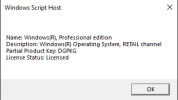
britechguy
Well-Known Member
- Reaction score
- 4,852
- Location
- Staunton, VA
Sky-Knight
Well-Known Member
- Reaction score
- 5,637
- Location
- Arizona
Win10 won't report OEM unless it's activated with a tier 1 key.
If you've got an OEM license that upgraded to 10, they're ALL retail now. At least in reporting... licensing wise you're supposed to consider it the more restrictive license.
If you've got an OEM license that upgraded to 10, they're ALL retail now. At least in reporting... licensing wise you're supposed to consider it the more restrictive license.
britechguy
Well-Known Member
- Reaction score
- 4,852
- Location
- Staunton, VA
At least in reporting... licensing wise you're supposed to consider it the more restrictive license.
Which comes right back to my point: I can't definitively know in a great many cases.
If Microsoft's own utilities are misleading, and clearly they are, then I'm sorry, but all bets are off. If I check a license using this utility on a machine unknown to me, and it says RETAIL, then that's what it is. Techs cannot be expected to know origins by divination.
For the sake of completeness, here's the output from the HP I'm typing on, which I know to have been a Windows 8.1 Home to Windows 10 Upgrade, done by me:
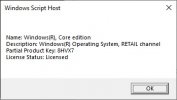
Last edited:
Similar threads
- Replies
- 48
- Views
- 1K
- Replies
- 25
- Views
- 2K
- Replies
- 10
- Views
- 840

